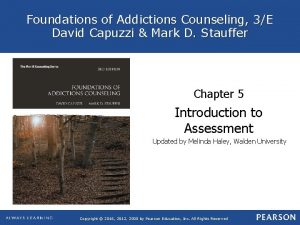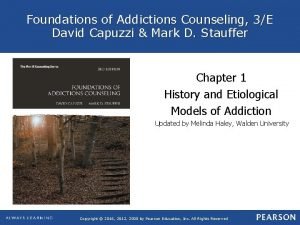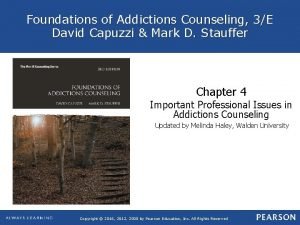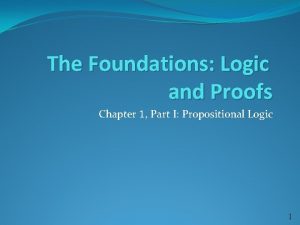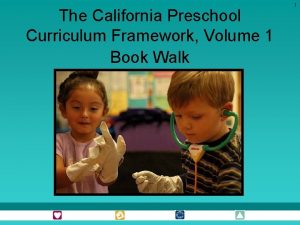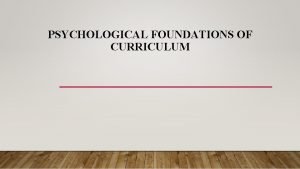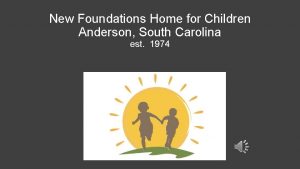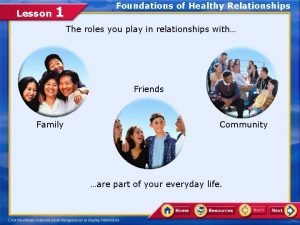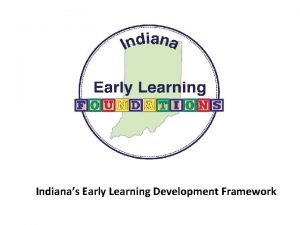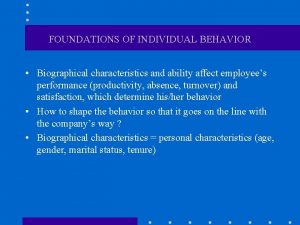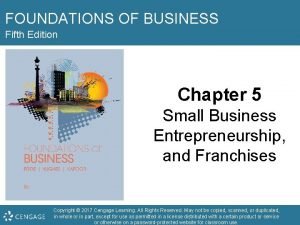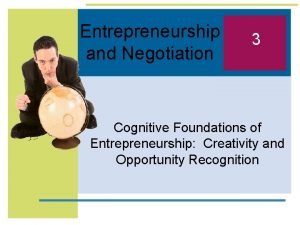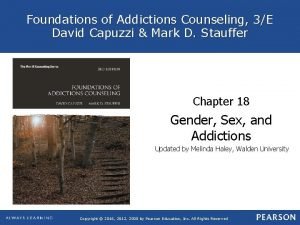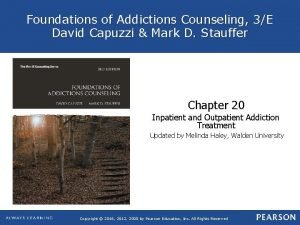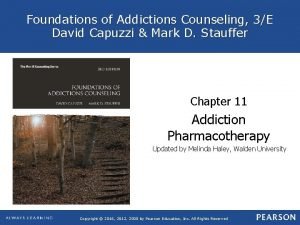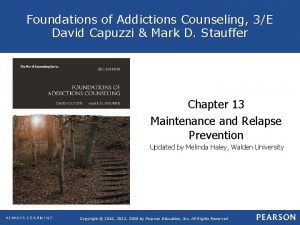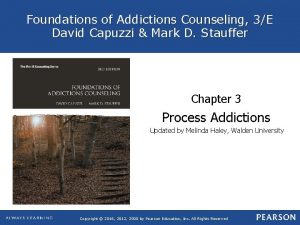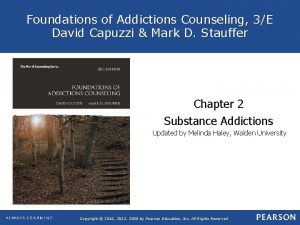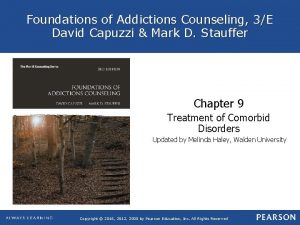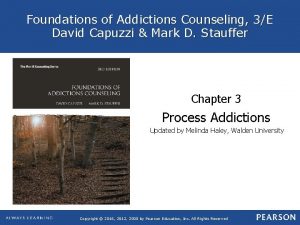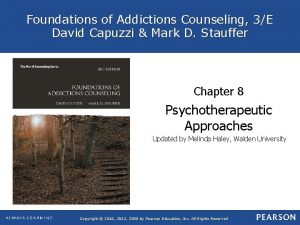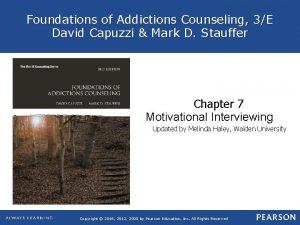Foundations of Addictions Counseling 3E David Capuzzi Mark















- Slides: 15

Foundations of Addictions Counseling, 3/E David Capuzzi & Mark D. Stauffer Chapter 15 Persons with Disabilities and Substance-Related and Addictive Disorders Updated by Melinda Haley, Walden University Copyright © 2016, 2012, 2008 by Pearson Education, Inc. All Rights Reserved

The Disability Community n n n Estimated 58 million people Largest and most diverse minority group Substance abuse & addiction problems n n Prevalence twice as high as that of the general population Often seen as secondary to other disability or not recognized Less likely to enter or complete treatment Other addictions n Eating disorders, gambling, sexual addictions Foundations of Addictions Counseling, 3 e Capuzzi & Stauffer Copyright © 2016, 2012, 2008 by Pearson Education, Inc. All Rights Reserved

Persons with Disabilities and Addictions n n Disabilities categorized by type, need for assistance, and severity Reasons for abuse may include n n n Coping with adjustment to disability More prescriptions may increase opportunity Isolation, depression, and financial issues Foundations of Addictions Counseling, 3 e Capuzzi & Stauffer Copyright © 2016, 2012, 2008 by Pearson Education, Inc. All Rights Reserved

Societal Barriers to Treatment n Societal beliefs about PWDs n n n n Don’t abuse substances Should receive identical treatment Should be allowed to engage in substances Require extreme efforts to serve Those with cognitive disabilities are not capable of learning to stay sober Counselor perception as fragile, helpless, sick, or abnormal Labels of social deviance Foundations of Addictions Counseling, 3 e Capuzzi & Stauffer Copyright © 2016, 2012, 2008 by Pearson Education, Inc. All Rights Reserved

Risks of Addiction for PWDs n Health and medical n n Medication can interact with substance Decreased tolerance Chronic pain medication Psychological n n n Enabling as family’s response to guilt, etc. Stresses in family Denial, anger, depression, embarrassment, etc. Foundations of Addictions Counseling, 3 e Capuzzi & Stauffer Copyright © 2016, 2012, 2008 by Pearson Education, Inc. All Rights Reserved

Risks of Addiction for PWDs, (continued) n Social n n Economic and employment n n n Social isolation Excess free time More likely victim of crime Higher bills for treatment, etc. Greater unemployment Access to treatment n n Physically inaccessible Accommodation often necessary Foundations of Addictions Counseling, 3 e Capuzzi & Stauffer Copyright © 2016, 2012, 2008 by Pearson Education, Inc. All Rights Reserved

Risks of Addiction for PWDs, (continued) n Four cultural perspectives on risk factors n n Sociocultural Physiological Psychological Developmental Foundations of Addictions Counseling, 3 e Capuzzi & Stauffer Copyright © 2016, 2012, 2008 by Pearson Education, Inc. All Rights Reserved

Types of Treatment n Stages of care n n n Number of venues n n Detoxification, rehabilitation, and aftercare Medical intervention may be required Inpatient, outpatient, or partial hospitalization Array of techniques n Integrated and inclusive Foundations of Addictions Counseling, 3 e Capuzzi & Stauffer Copyright © 2016, 2012, 2008 by Pearson Education, Inc. All Rights Reserved

Levels of Care American Society of Addiction Medicine (ASAM) n n Patient placement criteria in six categories Five levels of client care Assessment for PWDs must be n n n Culturally-specific Flexible Holistic manner Foundations of Addictions Counseling, 3 e Capuzzi & Stauffer Copyright © 2016, 2012, 2008 by Pearson Education, Inc. All Rights Reserved

Rehabilitations Settings n n n n Halfway or Transition Houses VA Hospitals General Hospitals Clinical Settings Programs for the Homeless Prisons and Jails Substance Abuse Programs Foundations of Addictions Counseling, 3 e Capuzzi & Stauffer Copyright © 2016, 2012, 2008 by Pearson Education, Inc. All Rights Reserved

Considerations for Treatment n n PWD’s life problems raise likelihood of relapse May need to include opportunities to: n n n n Learn activities of daily living Develop prevocational skills Learn social skills, healthy recreation Obtain financial benefits Develop parenting and childcare skills Build new peer networks Have information and services presented in simple language or in sign language Foundations of Addictions Counseling, 3 e Capuzzi & Stauffer Copyright © 2016, 2012, 2008 by Pearson Education, Inc. All Rights Reserved

Questions to Aid Assessment n n n Do you feel you have a disability, or has anyone ever told you that you have one? Have you ever seen a doctor for a long period of time, more frequently than just one visit or for routine check-ups? Do you take any kind of medication (prescription and over-thecounter)? Have you ever incurred any type of injury? If so, what type? What were the outcomes? Also ask about employment, hobbies, family and social life Consider cultural needs, cross addictions, gender Foundations of Addictions Counseling, 3 e Capuzzi & Stauffer Copyright © 2016, 2012, 2008 by Pearson Education, Inc. All Rights Reserved

Treatment for PWDs n n n Strengthen resiliency skills – psychosocial, emotional, mental, physical Promote healthy lifestyle changes and skills training Provide psychoeducation – decision-making, assertiveness, stress management, etc. Organize 12 -step programs in accessible spaces already used by PWDs Locate or establish peer-support programs n hidden disabilities and ethnic minorities Foundations of Addictions Counseling, 3 e Capuzzi & Stauffer Copyright © 2016, 2012, 2008 by Pearson Education, Inc. All Rights Reserved

Location of Treatment n Clients often treated for disabilities in one facility, addiction in another n n n Sequential or parallel treatment Parallel, unified, and comprehensive treatment best for PWDs Collaborative efforts across agencies needed n Independent Living Centers Foundations of Addictions Counseling, 3 e Capuzzi & Stauffer Copyright © 2016, 2012, 2008 by Pearson Education, Inc. All Rights Reserved

Useful Web Sites n Academy of Addiction Psychiatry (AAAP) n n http: //www. aaap. org National Institute on Alcohol Abuse and Alcoholism n http: //www. niaaa. nih. gov/ Foundations of Addictions Counseling, 3 e Capuzzi & Stauffer Copyright © 2016, 2012, 2008 by Pearson Education, Inc. All Rights Reserved
 Foundations of addictions counseling
Foundations of addictions counseling Foundations of addictions counseling
Foundations of addictions counseling Capuzzi and stauffer
Capuzzi and stauffer The real reason dinosaurs became extinct
The real reason dinosaurs became extinct Mark david chapman catcher in the rye
Mark david chapman catcher in the rye The foundations logic and proofs
The foundations logic and proofs Pre k curriculum california
Pre k curriculum california What are the five psychological foundations of curriculum
What are the five psychological foundations of curriculum New foundations anderson sc
New foundations anderson sc Foundations of a healthy relationship
Foundations of a healthy relationship Indiana early learning foundations
Indiana early learning foundations History and geography: the foundations of culture
History and geography: the foundations of culture Biographical characteristics advantages
Biographical characteristics advantages Foundations of business 5th edition
Foundations of business 5th edition Cognitive foundations of entrepreneurship
Cognitive foundations of entrepreneurship
